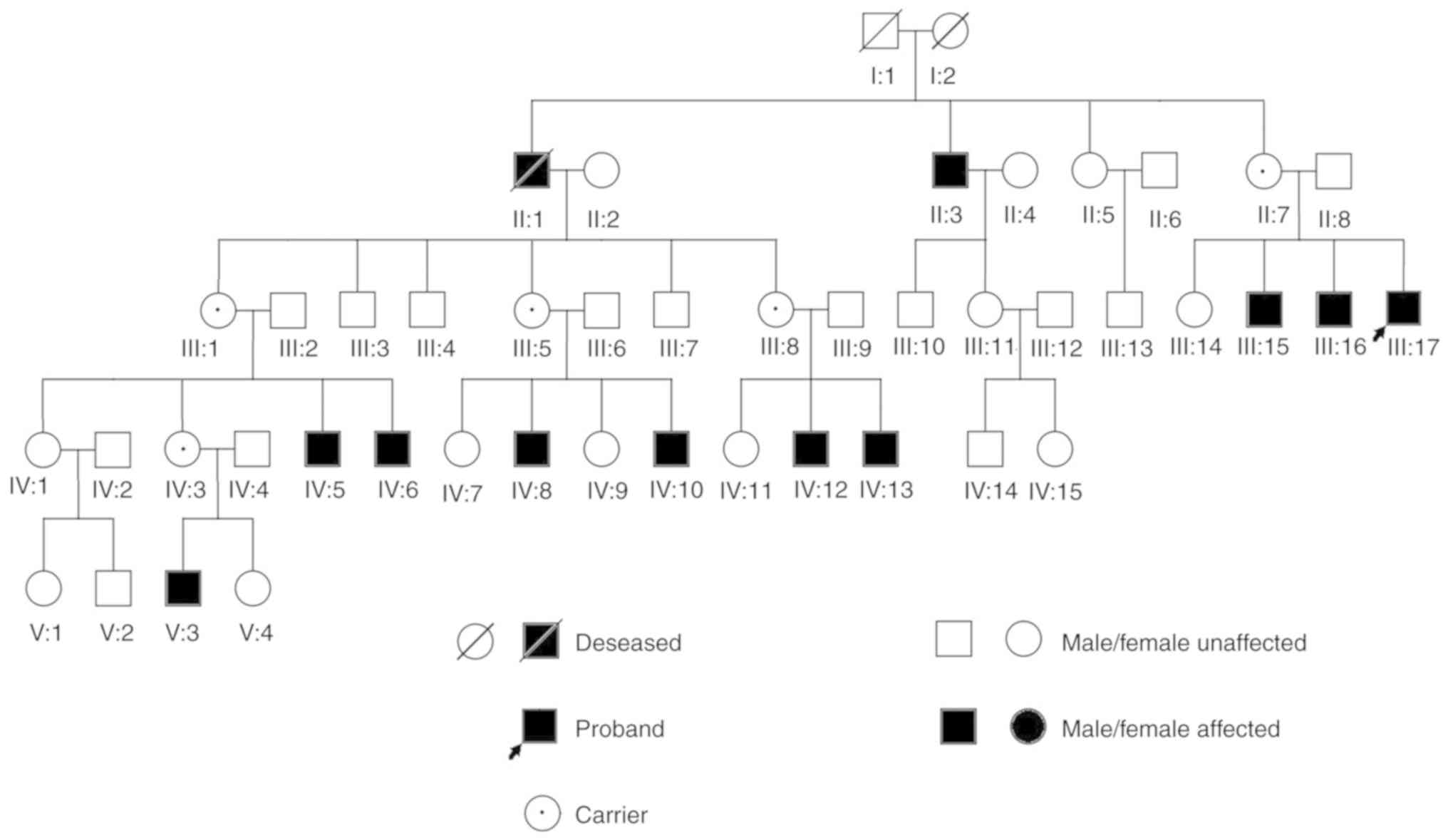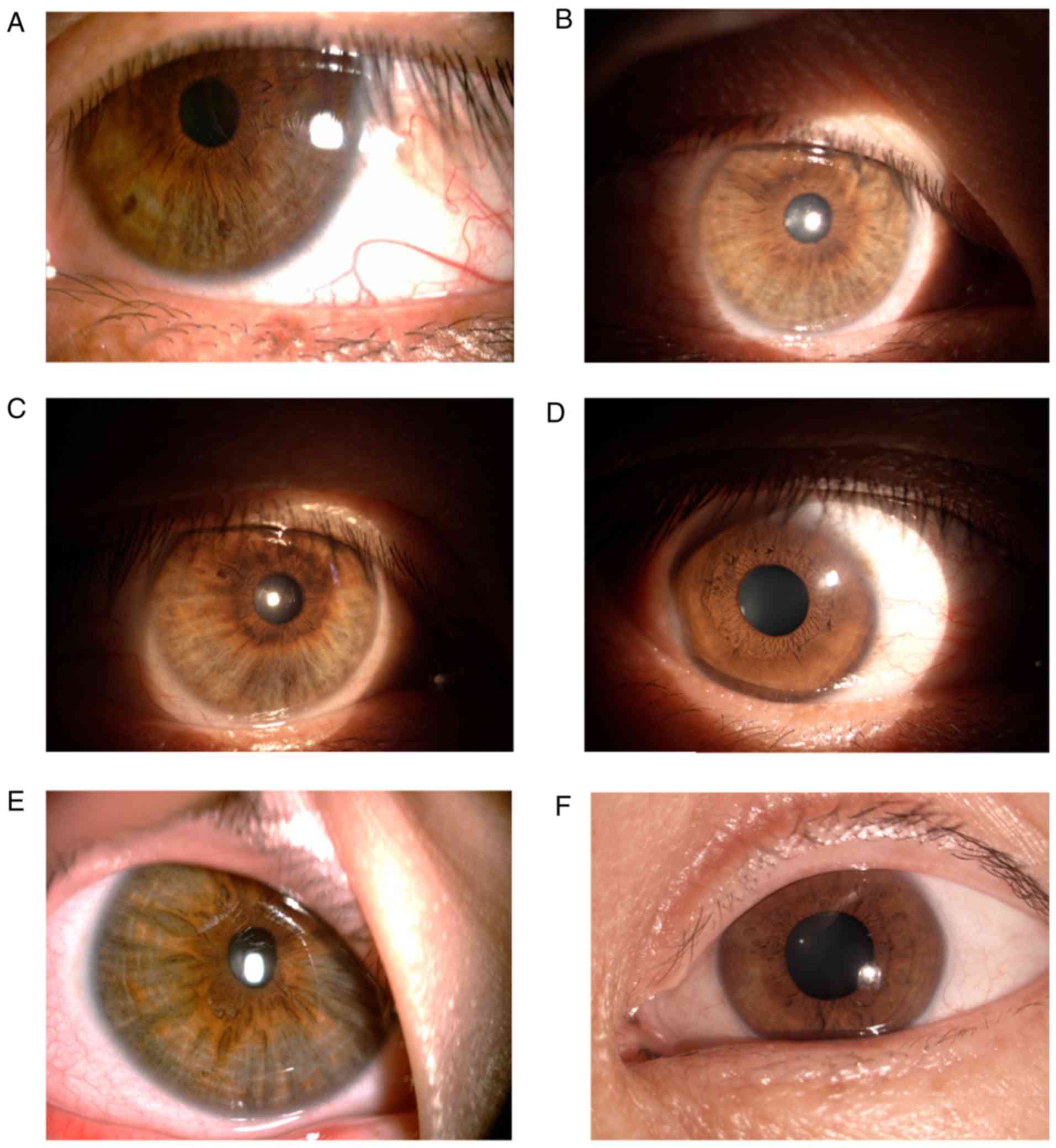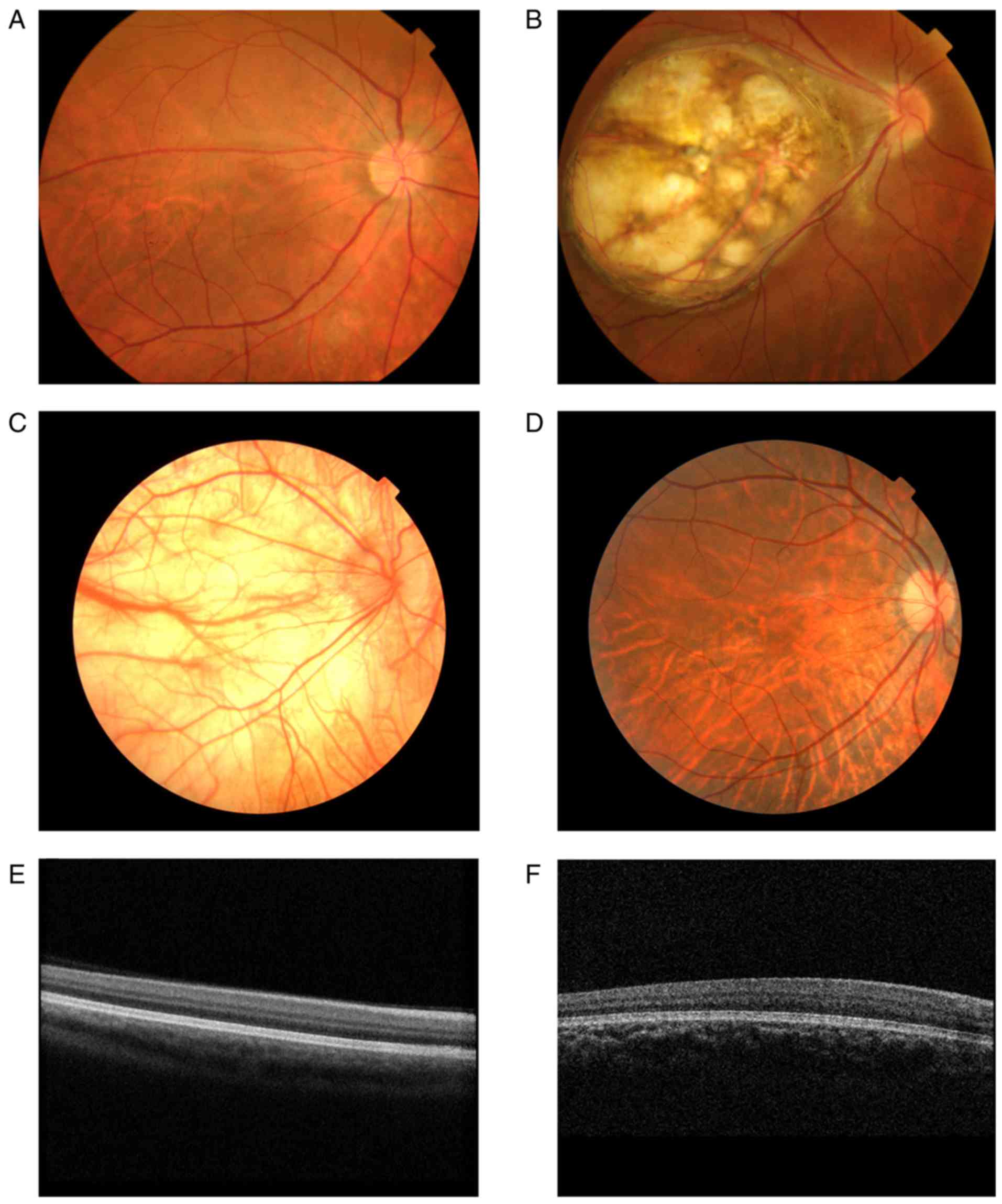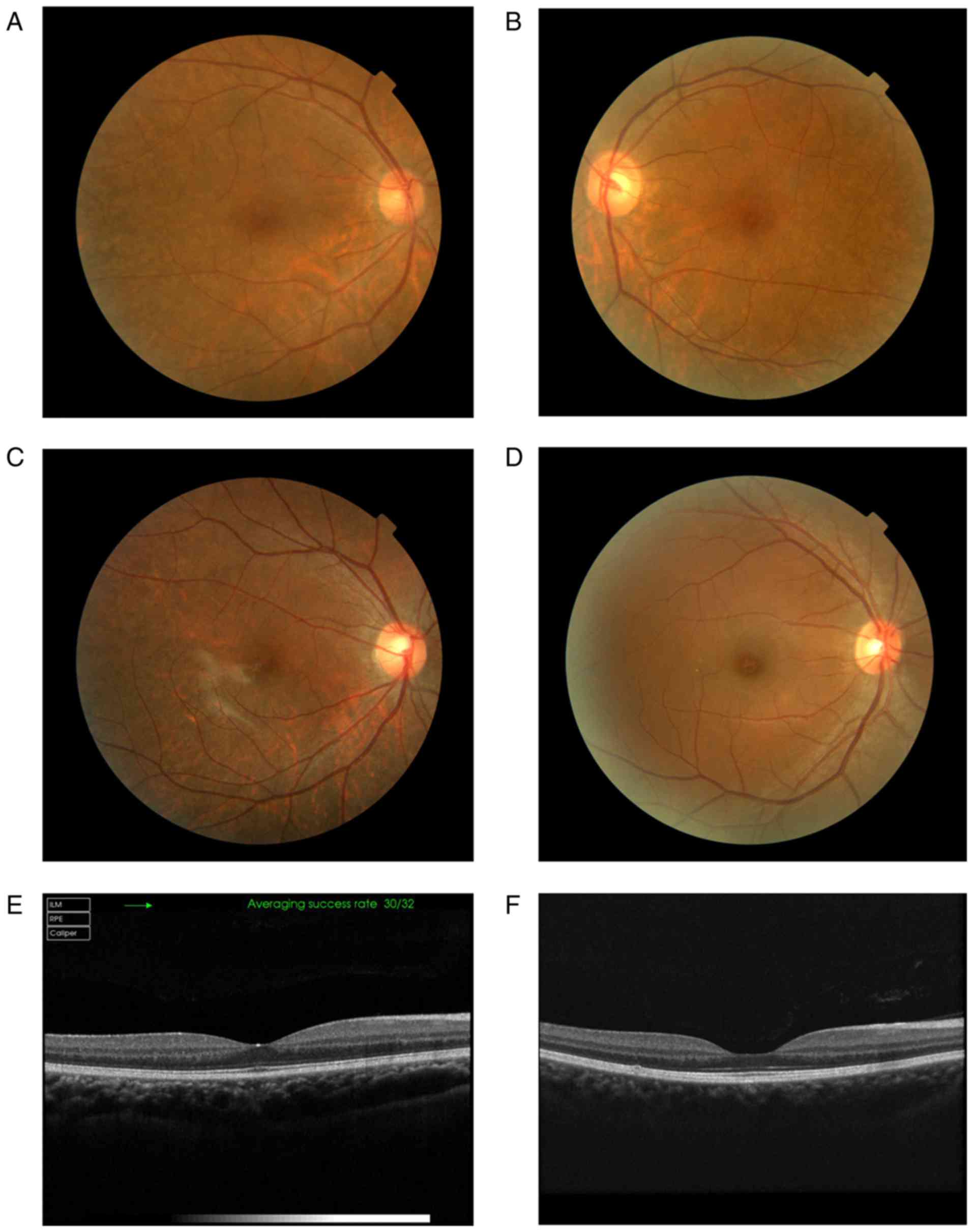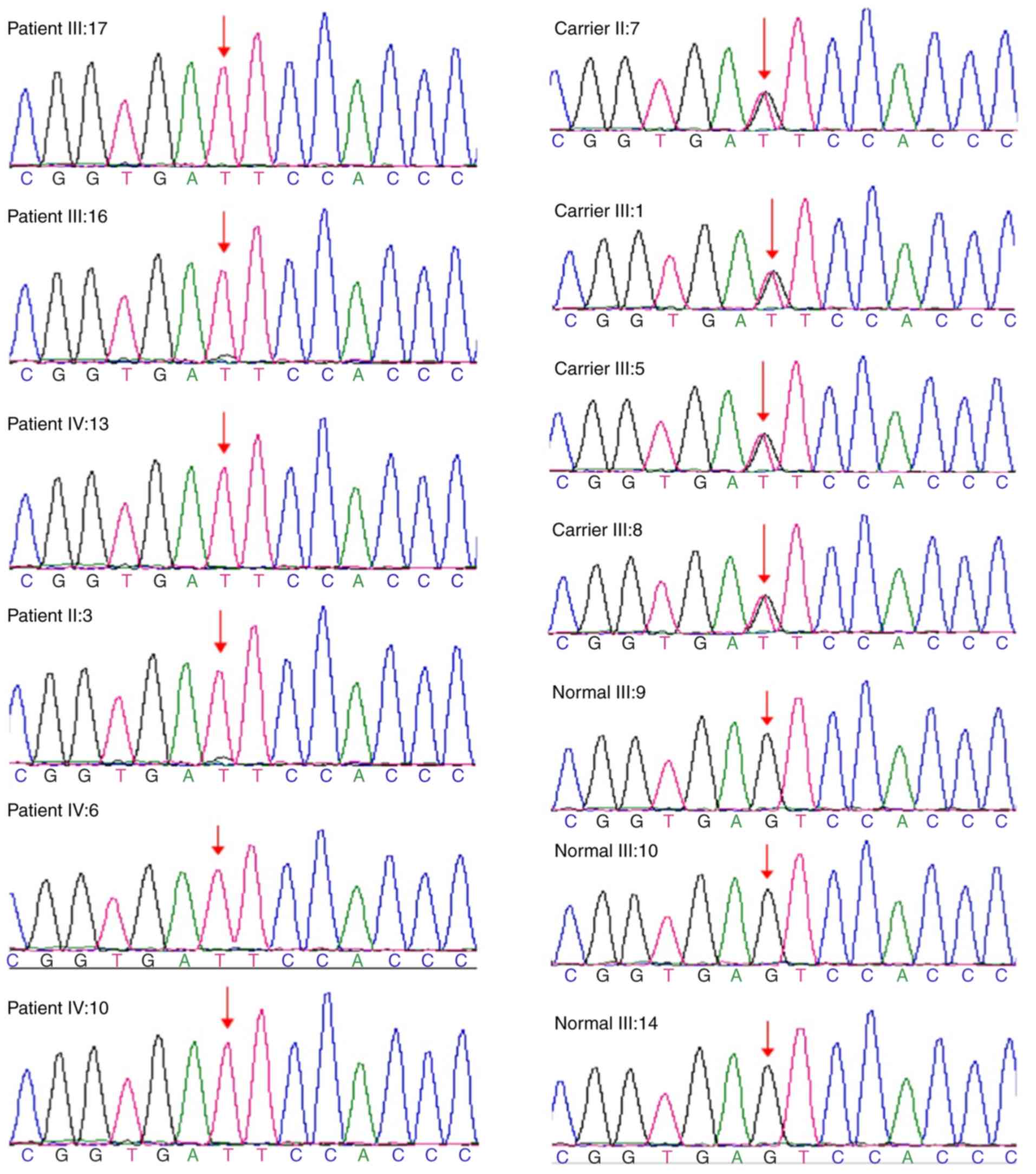|
1
|
Rosenberg T and Schwartz M: X-linked
ocular albinism: Prevalence and mutations-a national study. Eur J
Hum Genet. 6:570–577. 1998. View Article : Google Scholar : PubMed/NCBI
|
|
2
|
Preising M, Op de Laak JP and Lorenz B:
Deletion in the OA1 gene in a family with congenital X linked
nystagmus. Br J Ophthalmol. 85:1098–1103. 2001. View Article : Google Scholar : PubMed/NCBI
|
|
3
|
Sallmann GB, Bray PJ, Rogers S, Quince A,
Cotton RG and Carden SM: Scanning the ocular albinism 1 (OA1) gene
for polymorphisms in congenital nystagmus by DHPLC. Ophthalmic
Genet. 27:43–49. 2006. View Article : Google Scholar : PubMed/NCBI
|
|
4
|
Lam BL, Fingert JH, Shutt BC, Singleton
EM, Merin LM, Brown HH, Sheffield VC and Stone EM: Clinical and
molecular characterization of a family affected with X-linked
ocular albi-nism (OA1). Ophthalmic Genet. 18:175–184. 1997.
View Article : Google Scholar : PubMed/NCBI
|
|
5
|
O'Donnell FE Jr, King RA, Green WR and
Witkop CJ Jr: Autosomal recessively inherited ocular albinism. A
new form of ocular albinism affecting females as severely as males.
Arch Ophthalmol. 96:1621–1625. 1978. View Article : Google Scholar : PubMed/NCBI
|
|
6
|
Cortin P, Tremblay M and Lemagne JM:
X-linked ocular albinism: Relative value of skin biopsy, iris
transillumination and funduscopy in identifying affected males and
carriers. Can J Ophthalmol. 16:121–123. 1981.PubMed/NCBI
|
|
7
|
Zou X, Li H, Yang L, Sun Z, Yuan Z, Li H
and Sui R: Molecular genetic and clinical evaluation of three
Chinese families with X-linked ocular albinism. Sci Rep.
6:337132017. View Article : Google Scholar
|
|
8
|
Bassi MT, Schiaffino MV, Renieri A, De
Nigris F, Galli L, Bruttini M, Gebbia M, Bergen AA, Lewis RA and
Ballabio A: Cloning of the gene for ocular albinism type 1 from the
distal short arm of the X chromosome. Nat Genet. 10:13–19. 1995.
View Article : Google Scholar : PubMed/NCBI
|
|
9
|
Palmisano I, Bagnato P, Palmigiano A,
Innamorati G, Rotondo G, Altimare D, Venturi C, Sviderskaya EV,
Piccirillo R, Coppola M, et al: The ocular albinism type 1 protein,
an intracellular G protein-coupled receptor, regulates melanosome
transport in pigment cells. Hum Mol Genet. 17:3487–3501. 2008.
View Article : Google Scholar : PubMed/NCBI
|
|
10
|
d'Addio M, Pizzigoni A, Bassi MT,
Baschirotto C, Valetti C, Incerti B, Clementi M, De Luca M,
Ballabio A and Schiaffino MV: Defective intracellular transport and
processing of OA1 is a major cause of ocular albinism type 1. Hum
Mol Genet. 9:3011–3018. 2000. View Article : Google Scholar : PubMed/NCBI
|
|
11
|
Liu JY, Ren X, Yang X, Guo T, Yao Q, Li L,
Dai X, Zhang M, Wang L, Liu M and Wang QK: Identification of a
novel GPR143 mutation in a large Chinese family with congenital
nystagmus as the most prominent and consistent manifestation. J Hum
Genet. 52:565–570. 2007. View Article : Google Scholar : PubMed/NCBI
|
|
12
|
Wang Y, Guo X, Wei A, Zhu W, Li W and Lian
S: Identification of a novel mutation in a Chinese family with
X-linked ocular albinism. Eur J Ophthalmol. 19:124–128. 2009.
View Article : Google Scholar : PubMed/NCBI
|
|
13
|
Fang S, Guo X, Jia X, Xiao X, Li S and
Zhang Q: Novel GPR143 mutations and clinical characteristics in six
Chinese families with X-linked ocular albinism. Mol Vis.
14:1974–1982. 2008.PubMed/NCBI
|
|
14
|
Xiao X and Zhang Q: Iris hyperpigmentation
in a Chinese family with ocular albinism and the GPR143 mutation.
Am J Med Genet A 149A. 1786–1788. 2009. View Article : Google Scholar
|
|
15
|
Yan N, Liao X, Cai SP, Lan C, Wang Y, Zhou
X, Yin Y, Yu W and Liu X: A novel nonsense mutation of the GPR143
gene identified in a Chinese pedigree with ocular albinism. PLoS
One. 7:e431772012. View Article : Google Scholar : PubMed/NCBI
|
|
16
|
Cai CY, Zhu H, Shi W, Su L, Shi O, Cai CQ,
Ling C and Li WD: A novel splicing site mutation of the GPR143 gene
in a Chinese X-linked ocular albinism pedigree. Genet Mol Res.
12:5673–5679. 2013. View Article : Google Scholar : PubMed/NCBI
|
|
17
|
Pan Q, Yi C, Xu T, Liu J, Jing X, Hu B and
Wang Y: A novel mutation, c.494C>A (p.Ala165Asp), in the GPR143
gene causes a mild phenotype in a Chinese X-linked ocular albinism
patient. Acta Ophthalmol. 94:417–418. 2015. View Article : Google Scholar : PubMed/NCBI
|
|
18
|
Hu J, Liang D, Xue J, Liu J and Wu L: A
novel GPR143 splicing mutation in a Chinese family with X-linked
congenital nystagmus. Mol Vis. 17:715–722. 2011.PubMed/NCBI
|
|
19
|
Han R, Wang X, Wang D, Wang L, Yuan Z,
Ying M and Li N: GPR143 gene mutations in five chinese families
with X-linked congenital nystagmus. Sci Rep. 5:120312015.
View Article : Google Scholar : PubMed/NCBI
|
|
20
|
Kinnear PE, Jay B and Witkop CJ Jr:
Albinism. Surv Ophthalmol. 30:75–101. 1985. View Article : Google Scholar : PubMed/NCBI
|
|
21
|
Charles SJ, Green JS, Grant JW, Yates JR
and Moore AT: Clinical features of affected males with X linked
ocular albinism. Br J Ophthalmol. 77:222–227. 1993. View Article : Google Scholar : PubMed/NCBI
|
|
22
|
Schnur RE, Wick PA, Bailey C, Rebbeck T,
Weleber RG, Wagstaff J, Grix AW, Pagon RA, Hockey A and Edwards MJ:
Phenotypic variability in X-linked ocular albinism: Relationship to
linkage genotypes. Am J Hum Genet. 55:484–496. 1994.PubMed/NCBI
|
|
23
|
O'Donnell FE Jr, Green WR, Fleischman JA
and Hambrick GW: X-linked ocular albinism in Blacks. Ocular
albinism cum pigmento. Arch Ophthalmol. 96:1189–1192. 1978.
View Article : Google Scholar : PubMed/NCBI
|
|
24
|
Hayakawa M, Kanai A, Kato K, Nakajima A
and Takamori K: A Japanese family of nettleship falls X-linked
ocular albinism. Nippon Ganka Gakkai Zasshi (Japanese).
94:1181–1187. 1990.
|
|
25
|
Oetting WS: New insights into ocular
albinism type 1 (OA1): Mutations and polymorphisms of the OA1 gene.
Hum Mutat. 19:85–92. 2002. View Article : Google Scholar : PubMed/NCBI
|
|
26
|
Sone M and Orlow SJ: The ocular albinism
type 1 gene product, OA1, spans intracellular membranes 7 times.
Exp Eye Res. 85:806–816. 2007. View Article : Google Scholar : PubMed/NCBI
|
|
27
|
Schiaffino MV, d'Addio M, Alloni A,
Baschirotto C, Valetti C, Cortese K, Puri C, Bassi MT, Colla C, De
Luca M, et al: Ocular albinism: Evidence for a defect in an
intracellular signal transduction system. Nat Genet. 23:108–112.
1999. View Article : Google Scholar : PubMed/NCBI
|
|
28
|
Giordano F, Bonetti C, Surace EM, Marigo V
and Raposo G: The ocular albinism type 1 (OA1) G-protein-coupled
receptor functions with MART-1 at early stages of melanogenesis to
control melanosome identity and composition. Hum Mol Genet.
18:4530–4545. 2009. View Article : Google Scholar : PubMed/NCBI
|
|
29
|
Jia X, Yuan J, Jia X, Ling S, Li S and Guo
X: GPR143 mutations in Chinese patients with ocular albinism type
1. Mol Med Rep. 15:3069–3075. 2017. View Article : Google Scholar : PubMed/NCBI
|
|
30
|
Inoue K, Khajavi M, Ohyama T, Hirabayashi
S, Wilson J, Reggin JD, Mancia P, Butler IJ, Wilkison MF, Wegner M
and Lupski JR: Molecular mechnism for distinct neurological
phenotypes conveyed by allelic truncating mutations. Nat Genet.
36:361–369. 2004. View
Article : Google Scholar : PubMed/NCBI
|
|
31
|
Holbrook JA, Neu-Yilik G, Hentze MW and
Kulozik AE: Nonsense-mediated decay approaches the clinic. Nat
Genet. 36:801–808. 2004. View
Article : Google Scholar : PubMed/NCBI
|















